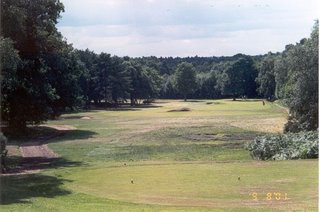The Central Bunker

The famous 16th at St. Andrew's.
A bunker placed in the centre of a landing area may be an immensely controversial choice, but it is a technique that should be used more. Let’s study some great examples to understand why.
The principal’s nose on the 16th at St. Andrew’s may be the first and earliest example of a central bunker. The weakest players are well short of this hazard and don’t give it much thought; in fact many just take dead aim right at it. The average player will usually bail well to the left to avoid the cluster and reduce the risk, whereas the best players must challenge the hazard to achieve the ideal approach to the green. The green is definitely best approached from right of the cluster, which also involves flirting with the out of bounds. The bunker makes this a hole full of decision making and creates an unusual and excellent example of risk and reward from the tee. 
The 4th at Woking.
The 4th at Woking was originally a very mundane hole until Paton placed two bunkers right in the middle of the fairway at the 230 yard mark. Golfers could play short of the hazards and face a tricky approach shot over a difficult greenside bunker, or they could take the aggressive approach of driving between the bunkers and the out of bounds, but be left with a straightforward little pitch to the green. The idea was so bold that it was met with a huge uproar in the club, but it was so clever that Tom Simpson was inspired by this great hole.
The Shoe bunker is in the centre of the picture
There are lots of other great examples to learn from such as Braid’s Bunker on the 2nd at Carnoustie, probably the most intimidating example of all of them. The 5th at Friar’s Head, a drivable par four where the bunker is 290 yards from the tee right in line with the green. The Shoe Bunker on the 2nd at Pacific Dunes, where a player has to decide whether to try skirt it or fly it. The long par five13th at Rustic Canyon has a central bunker with lots of room left or right, but somehow many end up stymied in the little central bunker.
I think the reason this is not used very often is the “F” word, fairness. Most players feel that they should always be rewarded for a straight drive and this seems to contradict with their beliefs. What they fail to realize is that the central bunker is placed primarily for decision making. Most players feel that it is there god given right to hit driver all day. Although this doesn’t take the driver out of their hands - they often choose another club because of the risks associated with flirting with the hazard - and they label this a weakness of the hole. The only weakness was in their courage. If we still played match play instead of stroke play, this hole type of hole would be more popular, but once again fairness influences architecture because we perfer stoke play. Admittedly this hazard must be used sparingly to work well, but with careful placement, this is an idea has produced some classic holes.

No comments:
Post a Comment